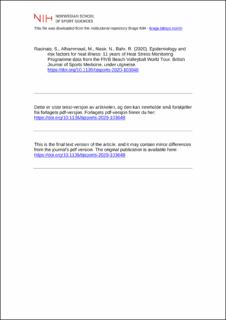Epidemiology and risk factors for heat illness: 11 years of Heat Stress Monitoring Programme data from the FIVB Beach Volleyball World Tour
Peer reviewed, Journal article
Accepted version
Permanent lenke
https://hdl.handle.net/11250/2727040Utgivelsesdato
2020Metadata
Vis full innførselSamlinger
- Artikler / Articles [2119]
- Publikasjoner fra Cristin [1107]
Sammendrag
Objectives: To analyse 11 years of FIVB heat stress-monitoring data to determine the relative influence of the different environmental parameters in increasing the likelihood of a heat-related medical time-out (MTOheat). Methods: A total of 8530 matches were recorded. The referee measured air temperature, black globe temperature, relative humidity and wet-bulb globe temperature (WBGT) before the matches, and registered the MTOheat. The absolute humidity was computed at posteriori. Results: There were 20 MTOheat cases, but only 3 resulted in forfeiting the match. MTOheat incidence was not statistically impacted by sex (p=0.59). MTOheat cases were more prevalent during the games played in Asia during the 4th quarter of the year (p<0.001). Two cases of MTOheat experienced diarrhoea or gastroenteritis during the 5 preceding days; both of them forfeited the match. A principal component analysis showed a specific environmental profile for the matches with MTOheat. They occurred at higher WBGT, temperatures and absolute humidity (p<0.001), but with a lower relative humidity (p=0.027). Conclusions: The current data showed that an increase in ambient or black globe temperature, but not relative humidity, increased the risk of a MTOheat; but that the absolute risk remained low in elite beach volleyball players. However, suffering or recovering from a recent illness may represent a risk factor for a MTOheat to lead to player forfeit.
Beskrivelse
I Brage finner du siste tekst-versjon av artikkelen, og den kan inneholde ubetydelige forskjeller fra forlagets pdf-versjon. Forlagets pdf-versjon finner du på bjsm.bmj.com / In Brage you'll find the final text version of the article, and it may contain insignificant differences from the journal's pdf version. The definitive version is available at bjsm.bmj.com
